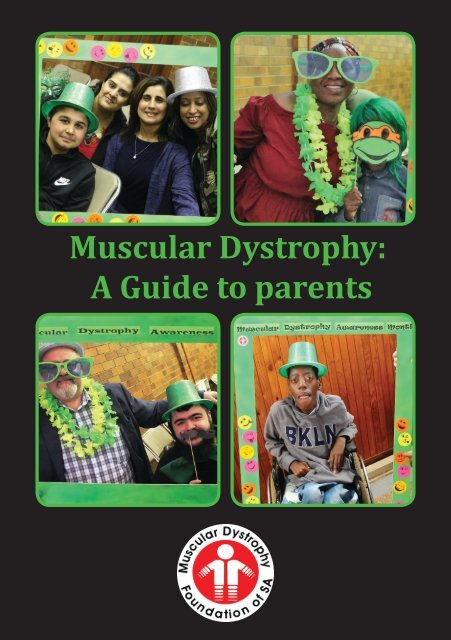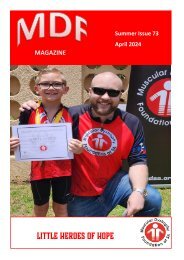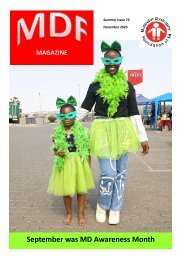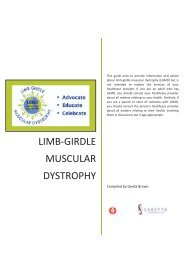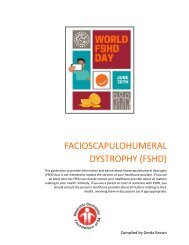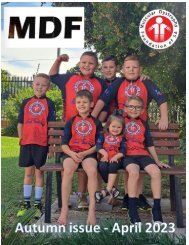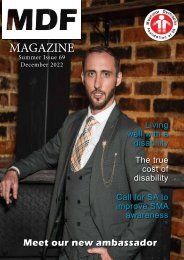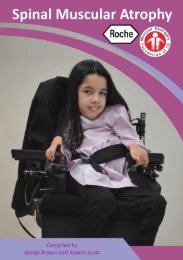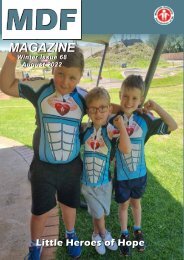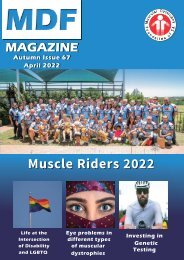Muscular Dystrophy A Guide to parents
Create successful ePaper yourself
Turn your PDF publications into a flip-book with our unique Google optimized e-Paper software.
<strong>Muscular</strong> <strong>Dystrophy</strong>:<br />
A <strong>Guide</strong> <strong>to</strong> <strong>parents</strong><br />
1
Contents<br />
1. Introduc<strong>to</strong>ry comments ................................................................................... 3<br />
2. The causes of muscular dystrophy ................................................................... 3<br />
3. Diagnosing muscular dystrophy ....................................................................... 4<br />
4. Treatment ......................................................................................................... 5<br />
4.1. General health ........................................................................................... 5<br />
4.2. Physical therapy and exercise .................................................................... 5<br />
4.3. Drug therapy .............................................................................................. 6<br />
4.4. Assisted devices and support aids ............................................................. 6<br />
4.5. Dietary changes ......................................................................................... 6<br />
4.6. Occupational therapy ................................................................................ 6<br />
4.7. Corrective surgery ...................................................................................... 7<br />
5. Emotional support ............................................................................................ 7<br />
5.1. Parents ....................................................................................................... 7<br />
5.2. Siblings ....................................................................................................... 8<br />
5.3. Affected child ............................................................................................. 9<br />
5.4. The school situation ................................................................................. 10<br />
5.5. Socialisation ..............................................................................................10<br />
5.6. Counselling .............................................................................................. 11<br />
6. Conclusion ..................................................................................................... 11<br />
7. Bibliography ................................................................................................... 12
ABOUT THE MUSCULAR DYSTROPHY FOUNDATION OF<br />
SOUTH AFRICA<br />
The <strong>Muscular</strong> <strong>Dystrophy</strong> Research Foundation of South Africa was founded in 1974 by<br />
Mr and Mrs New<strong>to</strong>n Walker of Potchefstroom, who at the time had a son affected with<br />
Duchenne muscular dystrophy. They felt there was a need <strong>to</strong> reach out <strong>to</strong> other <strong>parents</strong><br />
and families in a similar situation and also <strong>to</strong> support research in<strong>to</strong> this disease with the<br />
ultimate goal of finding a cure.<br />
Today the <strong>Muscular</strong> <strong>Dystrophy</strong> Foundation of South Africa (MDFSA) is a registered<br />
non-profit organisation – Reg. No. 004-152 NPO – consisting of a national office and<br />
three branches (Roodepoort, Cape Town and Durban) which operate in the nine<br />
provinces of South Africa.<br />
The mission of the Foundation is <strong>to</strong> support people affected by muscular dystrophy<br />
and neuromuscular disorders and endeavour <strong>to</strong> improve the quality of life of its<br />
members. We assist affected persons and their families by providing access <strong>to</strong> international<br />
information regarding specific dystrophies, workshops, support groups, referral <strong>to</strong><br />
genetic counselling and health facilities, and providing assistive devices when funding is<br />
available. We also strive <strong>to</strong> keep our members updated via the MDF website, Facebook<br />
page and in-house magazine.<br />
National Office<br />
12 Botes Street, Florida Park<br />
Tel 011 472-9703<br />
Website: www.mdsa.org.za<br />
Facebook: <strong>Muscular</strong> <strong>Dystrophy</strong> Foundation of South Africa<br />
Gauteng Branch (Gauteng, Free State, Mpumalanga, Limpopo and North West<br />
12 Botes Street, Florida Park<br />
Tel 011 472-9824<br />
KZN Branch (KwaZulu Natal and part of Eastern Cape)<br />
Office 7, 24 Somtseu Road, Durban<br />
Tel 031 332-0211<br />
Cape Town Branch (Western Cape, Northern Cape and part of Eastern Cape)<br />
3 Wiener Street, Goodwood<br />
Tel 021 592-7306<br />
2
1. Introduc<strong>to</strong>ry comments<br />
Every new day holds promise for children everywhere, even for youngsters affected<br />
with muscular dystrophy. The only difference is that children with muscular dystrophy<br />
cannot do things they enjoy without your assistance, patience and understanding and<br />
an ever-present helping hand. They will be whatever you enable them <strong>to</strong> be. Your role<br />
will not be easy, but remember that you can find the strength and guidance <strong>to</strong> care for<br />
them. Parents’ natural grief upon learning that their child has muscular dystrophy can<br />
make it difficult <strong>to</strong> absorb all the implications at once. It is therefore important <strong>to</strong> visit<br />
the doc<strong>to</strong>r, counsellor or social worker <strong>to</strong> discuss the matters of importance <strong>to</strong> you.<br />
Genetic counselling may also be discussed, especially after the initial implications of the<br />
diagnosis have sunk in.<br />
2. Causes of muscular dystrophy<br />
<strong>Muscular</strong> dystrophy (pronounced “dis-tro-fee”) is the name given <strong>to</strong> a group of more<br />
than 70 different neuromuscular disorders causing progressive wasting and weakness<br />
of the muscles. Each type presents differently and with its own levels of severity and<br />
complexity. They are characterised primarily by progressive muscle weakness, leading<br />
<strong>to</strong> secondary effects such as fatigue, increasingly limited physical activity, impaired<br />
balance and often collapsing. The prognosis varies according <strong>to</strong> the type of muscular<br />
dystrophy and the speed of progression. Some types are mild and progress very slowly,<br />
allowing normal life expectancy, while others are more severe and result in functional<br />
disability and loss of the ability <strong>to</strong> walk. Life expectancy may depend on the degree of<br />
muscle weakness and any respira<strong>to</strong>ry or cardiac complications.<br />
These disorders affect about 1 in 1 200 people in the general population, including<br />
children and adults of every race. The disorders are usually inherited, with the<br />
defective gene responsible for the weakening of the muscles being passed on from one<br />
generation <strong>to</strong> the next. However, muscular dystrophy can also occur in families<br />
where there is no prior his<strong>to</strong>ry of the condition. Respira<strong>to</strong>ry and cardiac diseases are<br />
common, and some patients may develop a swallowing disorder. <strong>Muscular</strong> dystrophy is not<br />
contagious and cannot be brought on by injury or activity.<br />
All of the muscular dystrophies result from a mutation in one of the thousands<br />
of genes that program the proteins that are critical for normal muscle health and<br />
development. The body’s cells do not work properly when a protein is altered or produced in<br />
insufficient quantity or sometimes missing completely. Genes are like blueprints: they<br />
contain coded messages that determine a person’s characteristics or traits. They are<br />
arranged along 23 rod-like pairs of chromosomes, with one half of each pair being<br />
inherited from each parent. Each half of a chromosome pair is similar <strong>to</strong> the other,<br />
except for one pair, which determines the sex of the individual.<br />
3
<strong>Muscular</strong> dystrophies can be inherited in three ways:<br />
• Au<strong>to</strong>somal dominant inheritance occurs when a child receives a normal gene from<br />
one parent and a defective gene from the other parent.<br />
• Au<strong>to</strong>somal recessive inheritance means that both <strong>parents</strong> must carry and pass on<br />
the faulty gene. The <strong>parents</strong> each have one defective gene but are not affected by<br />
the disorder. Children of either sex can be affected by this pattern of inheritance.<br />
• X-linked (or sex-linked) recessive inheritance occurs when a mother carries the<br />
affected gene on one of her two X chromosomes and passes it <strong>to</strong> her son (males<br />
always inherit an X chromosome from their mother and a Y chromosome from their<br />
father, while daughters inherit an X chromosome from each parent).<br />
3. Diagnosing muscular dystrophy<br />
<strong>Muscular</strong> dystrophy is diagnosed through a physical exam, a family medical his<strong>to</strong>ry, and<br />
tests.<br />
These might include the following:<br />
• Muscle biopsy – Muscle from patients with muscular dystrophy looks different from<br />
normal muscle, when seen under a microscope. The small piece of muscle that is<br />
removed during the biopsy is cut in<strong>to</strong> very thin slices, stained with a series of special<br />
dyes <strong>to</strong> show the different types of muscle fibres and studied by a pathologist.<br />
• Genetic testing – This looks for genes known <strong>to</strong> either cause or be associated with<br />
inherited muscle disease. DNA analysis and enzyme assays (measurements of<br />
enzyme activity) can confirm the diagnosis of certain neuromuscular diseases,<br />
including muscular dystrophy. Genetic linkage studies can identify whether a<br />
specific genetic marker on a chromosome and a disease are inherited <strong>to</strong>gether.<br />
• Electromyography - When muscles contract (shorten) there is electricity<br />
flowing through the muscle tissue. An abnormal muscle has an abnormal pattern of<br />
electricity that can be recognised and recorded using special equipment. An EMG<br />
test involves putting a small needle through the skin in<strong>to</strong> a muscle and recording<br />
the pattern of electricity in the muscle when it is contracting.<br />
• Blood and enzyme tests – These can detect defective genes and help identify<br />
specific neuromuscular disorders. CK is an enzyme (protein) that is important for<br />
energy production within muscle fibres. If a muscle fibre is damaged by a disease<br />
process such as muscular dystrophy, some of the CK leaks out in<strong>to</strong> the blood.<br />
Normally only a small amount is in the blood, but in muscular dystrophy there may<br />
be 10 <strong>to</strong> 100 times the normal amount. Very few other disease processes cause<br />
such a high level of CK in the blood.<br />
4
4. Treatment<br />
4.1. General health<br />
Your child’s general health is not necessarily affected by their muscular dystrophy<br />
condition, but the following points should be noted:<br />
• Affected children will be very susceptible <strong>to</strong> colds, which could lead <strong>to</strong> bronchitis<br />
and pneumonia. This is dangerous as their muscle weakness makes them less able <strong>to</strong><br />
cough effectively. If you are worried, call a doc<strong>to</strong>r. Never neglect a cold. Act swiftly.<br />
• It is important <strong>to</strong> avoid unnecessary bed rest or other forms of immobility, as this<br />
could in fact speed up the weakening of the muscles.<br />
• Obesity is a common and very trying problem. Generally it is due <strong>to</strong> the inevitable<br />
lack of muscular activity <strong>to</strong> “burn up” the excess intake. Everybody feels sorry for<br />
affected children, and <strong>to</strong>o many people can think of no better way <strong>to</strong> express their<br />
feelings than <strong>to</strong> provide the child with sweets and luxuries. There could be no more<br />
misplaced kindness. Excess weight restricts mobility even more and puts further<br />
strain on the carers. Restrict carbohydrate foods and if possible improve protein<br />
intake. If these habits are followed from an early age, no sudden changes will need <strong>to</strong><br />
be made during the early teen years, when other frustrations are already occurring.<br />
• Normal routine immunisations should be carried out. Doc<strong>to</strong>rs also recommend the<br />
influenza vaccine annually.<br />
4.2. 4.2. Physical therapy and exercise<br />
Physical therapy and exercise can minimise abnormal or painful positioning of the joints<br />
and prevent or delay deformities such as curvature of the spine. Regular, moderate<br />
exercise can improve movement and muscle strength, help maintain a range of motion,<br />
and keep muscles as flexible and strong as possible. These physical interventions help <strong>to</strong><br />
prevent muscle atrophy and delay the development of contractures.<br />
A programme is normally developed <strong>to</strong> meet the individual’s needs. For example:<br />
• Respira<strong>to</strong>ry care, deep breathing, and coughing exercises may be recommended for<br />
persons with a weakened diaphragm. Coughing and deep breathing exercises are<br />
designed <strong>to</strong> keep the lungs fully expanded.<br />
• Speech therapy may help those whose facial and throat muscles have weakened.<br />
The affected person can learn <strong>to</strong> use special communication devices, such as a<br />
computer with voice synthesiser.<br />
• Special exercises <strong>to</strong>gether with a special diet and feeding techniques may be<br />
recommended for people who have a swallowing disorder and struggle <strong>to</strong> convey<br />
food or liquid from the mouth <strong>to</strong> the s<strong>to</strong>mach.<br />
• Repeated low-frequency bursts of electrical stimulation <strong>to</strong> the thigh muscles can<br />
produce a slight increase in strength in boys with Duchenne muscular dystrophy.<br />
• Exercise options include passive stretching and postural correction exercises.<br />
Therapy should begin as soon as possible following diagnosis, before there is joint<br />
or muscle tightness.<br />
5
6<br />
4.3. Drug therapy<br />
Sadly there is still no definite cure for muscular dystrophy, although research is<br />
being conducted across the world <strong>to</strong> understand the disease better and ultimately find<br />
a cure. In some cases of muscular dystrophy, medicine may be prescribed <strong>to</strong> relieve<br />
symp<strong>to</strong>ms or delay disease progression and muscle degeneration. Corticosteroids such as<br />
prednisone, for example, can slow the rate of muscle deterioration in Duchenne<br />
muscular dystrophy and help children retain strength and prolong independent<br />
walking by as much as several years. Respira<strong>to</strong>ry infections may be treated with<br />
antibiotics. Medications also can be prescribed for some muscular dystrophy -related<br />
heart problems.<br />
4.4. Assistive devices and support aids<br />
Various assistive devices are needed <strong>to</strong> help maintain mobility and independence<br />
as the physical condition of a person deteriorates. Examples include canes, walkers,<br />
mo<strong>to</strong>rised wheelchairs, splints and braces, bath lifts, raised <strong>to</strong>ilet seats, pressure<br />
regulating mattresses, pressure care cushions, ventila<strong>to</strong>rs, speech aids, electric patient<br />
hoists, overhead bed bars (trapezes), orthopaedic appliances and other rehabilitative<br />
devices.<br />
Mobility is also linked <strong>to</strong> accessibility. Building alterations become necessary for this<br />
purpose, such as installing wheelchair ramps at entrances and modifying bathrooms <strong>to</strong><br />
accommodate wheelchair manoeuvres.<br />
4.5. Dietary changes<br />
Changes <strong>to</strong> the diet of those with muscular dystrophy have not been shown <strong>to</strong> slow<br />
the progression of the disease. Proper nutrition is essential, however, for overall<br />
health. Limited mobility or inactivity resulting from muscle weakness can contribute <strong>to</strong><br />
obesity, dehydration and constipation. A high-fibre, high-protein, low-calorie diet<br />
combined with recommended fluid intake may help. <strong>Muscular</strong> dystrophy patients with<br />
swallowing or breathing disorders and those persons who have lost the ability <strong>to</strong> walk<br />
independently should be moni<strong>to</strong>red for signs of malnutrition.<br />
4.6. Occupational therapy<br />
Occupational therapy attempts <strong>to</strong> help people maintain their normal skills and activities<br />
at work or in other spheres. By so doing it can help some people with muscular dystrophy<br />
<strong>to</strong> deal with progressive weakness and loss of mobility. Some individuals may need <strong>to</strong><br />
learn new job skills or new ways <strong>to</strong> perform tasks, while other persons may need <strong>to</strong> change<br />
jobs. Assistive technology may include modifications <strong>to</strong> home and workplace settings<br />
and the use of mo<strong>to</strong>rised wheelchairs, wheelchair accessories, and adaptive utensils.
4.7. Corrective surgery<br />
Surgery may be performed <strong>to</strong> ease complications from muscular dystrophy. Surgery <strong>to</strong><br />
reduce the pain and postural imbalance caused by scoliosis may help some patients.<br />
Scoliosis occurs when the muscles that support the spine begin <strong>to</strong> weaken and can<br />
no longer keep the spine straight. The spinal curve, if <strong>to</strong>o great, can interfere with<br />
breathing and posture, causing pain. Another option is spinal fusion, in which bone is<br />
inserted between the vertebrae in the spine and allowed <strong>to</strong> grow, fusing the vertebrae<br />
<strong>to</strong>gether <strong>to</strong> increase spinal stability.<br />
5. Emotional support<br />
5.1. Parents<br />
People react <strong>to</strong> this diagnosis differently. Each has his or her own strengths,<br />
resources, networks and ways of coping. Some may take weeks or months <strong>to</strong> adjust <strong>to</strong> the<br />
diagnosis, hoping the terrible prognosis will go away. Others understandably react<br />
with shock, anger and sadness. They may be angry with the doc<strong>to</strong>r who gave them the<br />
diagnosis, angry with their spouse or with themselves. It may take some time<br />
before a family develops its own way of living with a family member who has muscular<br />
dystrophy and is able <strong>to</strong> deal with the issues this brings. The process of coping is<br />
continuous and will vary over time in response <strong>to</strong> the changes and needs of the<br />
situation. There will be highs and lows, and as long as the way used <strong>to</strong> cope by the<br />
family is not self-destructive and does not hurt anyone, then it is appropriate and should<br />
be respected. There is no right or wrong way and each family will find what works for them.<br />
Drawing on their own resources and the support and experience of others can be useful.<br />
The natural inclination of <strong>parents</strong> is <strong>to</strong> protect their disabled child from<br />
knowledge of the disorder and from the apparent cruelty of the outside world, but this<br />
could lead <strong>to</strong> overprotection. This may frustrate the child’s normal impulse <strong>to</strong>wards<br />
independence, especially in early adolescence, and may hamper their ability <strong>to</strong><br />
make friends. Friendship both within the family and outside is very important for<br />
the affected person. Parents should not be embarrassed about exposing their<br />
child within the community. In this respect, young disabled adolescents should be<br />
granted the space and independence <strong>to</strong> test their own emotions, creativity, and<br />
social capability and be encouraged and supported <strong>to</strong> develop their leadership abilities.<br />
Looking after a disabled youngster is not an easy task and there are more than the<br />
normal share of problems. One parent-made problem is the tendency <strong>to</strong> be <strong>to</strong>o<br />
anxiously sympathetic. A feeling of self-sufficiency and independence is so necessary for<br />
the child’s mental health. The parent should institute a schedule of everyday activities<br />
– simple things that the child knows they can do with little or no help. They will learn<br />
self-respect that comes from achievement, which is so vital for maintaining an interest<br />
in life.<br />
7
This brings us <strong>to</strong> the point of your own needs. In your devotion <strong>to</strong> looking<br />
after your disabled child, do not forget your own needs. Try <strong>to</strong> stay involved<br />
with social, community or other matters of interest <strong>to</strong> you. Allow yourself short<br />
breaks of a few hours every week. You need time off <strong>to</strong> retain perspective.<br />
Naturally, at times, feelings of depression could occur within the family, but it is<br />
not common for children who have muscular dystrophy. Parental feelings of guilt<br />
and a tendency <strong>to</strong> blame oneself is often the reason for depression. The sooner<br />
you rid yourself of this blame the better. Nothing about the situation is your fault.<br />
Plan for the future. Even if you have few assets, it’s important <strong>to</strong> draw up a will, appoint<br />
guardians, outline your wishes for your affected child’s care, and establish a special<br />
needs trust, in case your child outlives you (Medvescec, 2004).<br />
5.2. Siblings<br />
Because special attention is given <strong>to</strong> the affected child, other children within the<br />
family may feel jealous. Obviously everyone wishes a disabled child <strong>to</strong> live the fullest life<br />
possible, and the nature of muscular dystrophy and the deterioration of strength make<br />
more attention and assistance necessary for the affected child. This is not favouritism<br />
but essential care, and this should be carefully explained <strong>to</strong> the child’s siblings. It is<br />
therefore important <strong>to</strong> help brothers and sisters realise that they are equally loved and<br />
encourage them <strong>to</strong> have empathy with the affected child and behave lovingly <strong>to</strong>wards them.<br />
Christina Medvescek (2004) writes as follows about siblings in this situation:<br />
8<br />
… the sibling experience isn’t easy, especially as children see their affected brother or<br />
sister decline physically. Sadness, resentment, jealousy, embarrassment, frustration,<br />
guilt and not a little fear — all are part of the s<strong>to</strong>ry.<br />
Siblings usually have the longest-lasting relationships in a family. It’s not uncommon<br />
for an adult sibling, having outlived the <strong>parents</strong>, <strong>to</strong> take on caregiving responsibilities<br />
for an affected brother or sister.<br />
Families that foster a climate of security, belonging, love and caring — all the positives<br />
of a healthy family system — generally have children who cope well with the daily<br />
realities of neuromuscular disease, says Arden Peters, a psychologist… .<br />
But a good family climate can’t guarantee that kids won’t struggle with their<br />
difficult roles. Signs that siblings may be having trouble coping include: greater-than-normal<br />
bickering, anger, jealousy and complaining; acting out at school or home; sleep<br />
disturbances; clinging; and (ironically) overachieving and trying <strong>to</strong> be “perfect<br />
How do you set a good family climate?<br />
• Be open and honest with children about the disability. “Parents should openly<br />
communicate about the disease process, treatment regime and especially their<br />
feelings,” says Laura Frobel, a social worker… .<br />
When younger children start asking questions about death, they’re ready <strong>to</strong> begin
talking about it. If older children haven’t asked about death, maybe they’re worried<br />
they’ll cause something bad <strong>to</strong> happen by bringing it up.<br />
“Children need <strong>to</strong> know that when <strong>parents</strong> cry about such things, it’s a sign of love<br />
and the children have done the right thing, not the wrong thing, in talking about<br />
it,” says Peters. …<br />
• Listen. Children don’t always need you <strong>to</strong> fix things. A sympathetic ear and a hug<br />
can go a long way. Be strong enough <strong>to</strong> bear their “bad” feelings. Counselling can be<br />
a valuable <strong>to</strong>ol for some children, but non-talkative children may just need <strong>to</strong> know<br />
they can talk <strong>to</strong> you if they need <strong>to</strong>. …<br />
• Treat them as individuals. … Don’t lay on guilt by emphasizing how much luckier<br />
they are than their affected siblings. Find time <strong>to</strong> connect privately with each child.<br />
Give them private space. Take vacations that cater <strong>to</strong> their interests, not just built<br />
around hospital visits or physical limitations. Help them connect with a caring adult<br />
who is there just for them. Let overachievers know you love them for who they are,<br />
not what they do.<br />
• Don’t expect children <strong>to</strong> assume adult roles. Caregiving is a character-building<br />
experience and many siblings say they’ve benefited from it. Too much caregiver<br />
responsibility robs siblings of their growing-up experiences, and can make them<br />
bossy and authoritarian. How much is <strong>to</strong>o much? The key is that the <strong>parents</strong> remain<br />
in charge, and that they ensure helper siblings get <strong>to</strong> be kids <strong>to</strong>o.<br />
• Remember they’re young. Even though they understand intellectually that<br />
their siblings with disabilities need more attention, children don’t yet have good<br />
emotional control and often act immaturely. Be patient.<br />
5.3. Affected Child<br />
Very young children will not understand any details of the diagnosis, but those who<br />
are already aware of their problem will welcome an opportunity <strong>to</strong> discuss what is<br />
happening <strong>to</strong> them. How much a child should be <strong>to</strong>ld depends on their own<br />
curiosity and emotional make-up. Your child’s questions should be a good indica<strong>to</strong>r of<br />
what he or she is ready <strong>to</strong> hear. As a general rule, do not volunteer disturbing information<br />
needlessly. It is recommended that you are open and honest from the very beginning.<br />
I was officially diagnosed with congenital muscular dystrophy at age 4, but I was<br />
always aware of my disability. I recognised that I was different from my peers – I<br />
was unable <strong>to</strong> walk, run and climb steps. I also looked different – I was very thin<br />
as a child, I had contractures and scoliosis causing asymmetry of the <strong>to</strong>rso. My<br />
<strong>parents</strong> <strong>to</strong>ld us that I have something called muscular dystrophy, meaning I have<br />
much weaker muscles than other children. At that age, this was enough knowledge<br />
for me. For many years, when other children would ask the inevitable question,<br />
‘what’s wrong with you? ’I would simply answer, ‘I’ve got muscular dystrophy so I<br />
can’t walk like you’.<br />
9
10<br />
It is also important <strong>to</strong> consider siblings, as they should be included in any discussions<br />
you have as a family. However, refrain from telling siblings more about the condition<br />
than the affected child. Any information you choose <strong>to</strong> share with your children should<br />
be fair and equal.<br />
Independence and confidence is a very important skill, particularly in coping with a<br />
variety of people and situations. It is therefore important for your child <strong>to</strong> participate<br />
in activities outside the home. Not only does participation develop independence<br />
and a positive self-image, but the activities themselves provide a wonderful source of<br />
pleasure and enjoyment.<br />
Above all else your child must feel loved and supported by you and your family.<br />
Sometimes the comfort of a loving hug is all the reassurance they want and need.<br />
5.4. Education<br />
Education is important <strong>to</strong> everyone, including disabled individuals, who have<br />
the same potential as anyone intellectually. Physical challenges at school such as<br />
moving from class <strong>to</strong> class, climbing stairs and carrying a suitcase should be overcome by<br />
arrangement with the principal, teacher and schoolmates. The presence of<br />
occasional pupils in wheelchairs in any mainstream school may in fact be an advantage <strong>to</strong><br />
everyone, giving the affected children the opportunity <strong>to</strong> live in a regular environment,<br />
and their schoolmates the opportunity <strong>to</strong> recognise the problems of the disabled.<br />
Special schools for the disabled, however, give them opportunities <strong>to</strong> see themselves as<br />
only one of a great many disabled people. Another advantage of special schools could<br />
be the services available, such as physiotherapy, nursing supervision and a chance <strong>to</strong><br />
learn <strong>to</strong> use special equipment and techniques <strong>to</strong> overcome physical difficulties. The<br />
best solution should be sought for each individual child. Often the child will first attend<br />
a mainstream school (the so-called ‘normal’) school, but they should change <strong>to</strong> a special<br />
needs school before their needs become critical and result in an emergency situation.<br />
As previously mentioned, the diagnosis could reduce life expectancy or result in<br />
functional disability. Despite this prognosis it is important that children do attend<br />
school that provide educational programs <strong>to</strong> enable them <strong>to</strong> find meaningful work once<br />
they have left school.<br />
5.5. Socialisation<br />
It is important that your child has contact with a broad range of people for his or her<br />
development. Contact with those who do not have the disorder will help your child <strong>to</strong><br />
not feel different, while contact with other children with muscular dystrophy will give<br />
him or her opportunity <strong>to</strong> be themselves.
A group of children diagnosed with muscular dystrophy can talk about how they feel<br />
and how they deal with certain situations in a way that is different from talking with<br />
their <strong>parents</strong>. This peer support is invaluable, something which plays a big role in the<br />
life of any teenager or young adult.<br />
5.6. Counselling<br />
Given the demands and challenges of situations they meet, at times a family may find<br />
it useful <strong>to</strong> seek professional counselling and assistance. This should be thought of as a<br />
positive and constructive action rather than a failure or weakness.<br />
The <strong>Muscular</strong> <strong>Dystrophy</strong> Foundation of South Africa will give you as much support<br />
as it can. Join the Foundation and our social work team can provide support in terms<br />
of individual therapy, family therapy, or group therapy; or you can just simply meet<br />
others with similar problems <strong>to</strong> comfort and advise each other by telephone or through<br />
support group meetings.<br />
6. Conclusion<br />
There cannot, of course, be a single right answer <strong>to</strong> every problem. Every child’s set of<br />
circumstances is different, and the advice given should be shaped <strong>to</strong> fit the individual.<br />
But remember that you are not alone with your problem.<br />
11
7. Bibliography<br />
Life on the slow lane. Disability & lifestyle blog. http://www.lifeontheslowlane.co.uk/<br />
Medvescek, C. 2004. “The other children in the family”, Quest, January–February 2004,<br />
as excerpted online by the <strong>Muscular</strong> <strong>Dystrophy</strong> Association in Learning <strong>to</strong> live with<br />
neuromuscular disease: A message for <strong>parents</strong>. https://www.mda.org/sites/default/<br />
files/publications/Learning_<strong>to</strong>_Live_P-195.pdf<br />
<strong>Muscular</strong> <strong>Dystrophy</strong> Association. 2011. Learning <strong>to</strong> live with neuromuscular disease:<br />
A message for <strong>parents</strong>. www.mda.org/sites/default/files/publications/Learning_<strong>to</strong>_<br />
Live_P-195.pdf<br />
<strong>Muscular</strong> <strong>Dystrophy</strong> Association / <strong>Muscular</strong> <strong>Dystrophy</strong> Australia. 2018. DMD – A guide<br />
for <strong>parents</strong>. https://www.mda.org.au/wp-content/uploads/2018/07/DMD_A-<strong>Guide</strong>_<br />
for_Parents.pdf<br />
<strong>Muscular</strong> <strong>Dystrophy</strong> Foundation of South Africa. A guide <strong>to</strong> <strong>parents</strong>. http://www.mdsa.<br />
org.za<br />
<strong>Muscular</strong> <strong>Dystrophy</strong> Foundation of South Africa. 2016. Orientation programme, 30<br />
June. Florida.<br />
PLEASE NOTE<br />
12<br />
The treatments and drugs mentioned in this fact sheet are for information purposes<br />
ONLY. Please consult your physician or other health care specialist for information<br />
regarding the use of any of the above.
A heartfelt thank you <strong>to</strong> FC Robb Charitable Trust for donating the funding <strong>to</strong> make this<br />
book possible.
14


